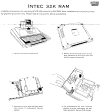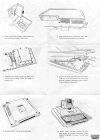 |
 |
Out of Memory? |
 My first Atari computer back in the middle 80's was an 800XL with 64k. After
a while, I bought a 48k 800 for running those programs that even the Translator
disk couldn't handle, so I never knew the limitations of running a machine with
less than 48k for a long time. When a 16k 400 became available to me, I grabbed
it, brought it home, and quickly found out how limiting 16k can be, especially
if you want to run a floppy drive. I wanted to upgrade the memory, but every
person I talked to and every magazine article I read declared the 400 not
upgradeable without buying an expensive upgrade and sending your machine out to
have it installed.
My first Atari computer back in the middle 80's was an 800XL with 64k. After
a while, I bought a 48k 800 for running those programs that even the Translator
disk couldn't handle, so I never knew the limitations of running a machine with
less than 48k for a long time. When a 16k 400 became available to me, I grabbed
it, brought it home, and quickly found out how limiting 16k can be, especially
if you want to run a floppy drive. I wanted to upgrade the memory, but every
person I talked to and every magazine article I read declared the 400 not
upgradeable without buying an expensive upgrade and sending your machine out to
have it installed.
I was not deterred, however, and proceeded to open up my machine to see what could be done about it. Getting the beige, plastic shell open was easy enough. I was then faced with the monolithic aluminum shell that provides RFI insulation for the mainboard. Once I got past my initial fear about proceeding further, however, it was relatively easy. I still needed a memory board to replace my old one with, though, so I took a trip to my local Atari dealer who happened to have a 32k board for the 800 collecting dust on the shelf, so I bought it and the experiment began in earnest.
 We
need to go through a little history, here, to give you more of a feel for the
Atari scene back in those days. In the early to middle 80's, it was a common
practice for users to pull out one of the memory boards in the 800 and replace
it with a hardware device of some kind. Real time clocks, machine language
monitors, 80 column cards and others were available that fit these slots. To add
these, though, meant sacrificing some memory, so memory boards were released
with extra RAM on them so you could still install your device and have 48k. The
32k board that I bought is just such a product. Installing this in an 800 along
with a standard 16k board gives you 48k and frees up a slot for devices.
We
need to go through a little history, here, to give you more of a feel for the
Atari scene back in those days. In the early to middle 80's, it was a common
practice for users to pull out one of the memory boards in the 800 and replace
it with a hardware device of some kind. Real time clocks, machine language
monitors, 80 column cards and others were available that fit these slots. To add
these, though, meant sacrificing some memory, so memory boards were released
with extra RAM on them so you could still install your device and have 48k. The
32k board that I bought is just such a product. Installing this in an 800 along
with a standard 16k board gives you 48k and frees up a slot for devices.
Upgrading the RAM on an 800 involves pulling out the memory boards under the cover and replacing them with boards with a higher memory capacity, but the 400 doesn't have memory boards under the cover leaving many owners feeling that they are stuck with whatever memory came with their machine. DOS is relatively big, so you can't connect a floppy to a 400 until you do something about the memory. Good news, though. The 400 can be upgraded, but it's a little bit trickier.
First of all, the 400 only has one memory slot onboard as opposed to the 3 on the 800. This isn't as limiting a factor as you would think, though. Now for the tricky bit. What you have to do is disassemble your 400 to get at the memory slot. It is housed underneath the heavy aluminum shell that I mentioned earlier.You can do this with just a screwdriver. Once you have the aluminum shell detached, you now have access to your lone memory slot. Simply remove the stock memory board and replace it with one of a higher capacity. There is another slot under there, which is also present on the 800, but that is not for memory. It is designed for testing and troubleshooting by a technician, so ignore it. Reassemble it all, power it on and in Basic type PRINT FRE(0) to see your new memory size. I have been running a 400 with a 32k board designed for the 800 for some time now, and it works great with no other modifications being necessary.
I hope this helps someone with a 400 who wants to run DOS and has access to a memory board with more than 16k. Maybe you can find someone in the Atari community with the skill to upgrade your stock boards or who has an upgraded board they are willing to part with.
| Name: | |
| Subject: | |
| Comment: | |
| Check: | What is the greatest video game company of all time? (Hint: Atari.) |